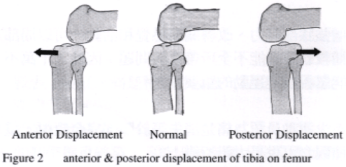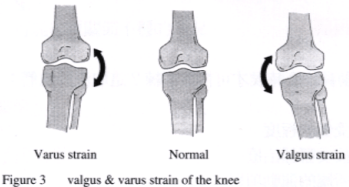Sports Medicine Education No. VI - Ligamentous Injury of the Knee
Ligamentous Injury of the Knee Joing
Ligamentous injuries of the knee are common in sports. Knee stability depends a lot on the integrity of the knee ligament. Injury is resulted when the demand exceeds the capability of the ligaments.
Anatomy
The functions of knee ligaments are:
- To stabilise the joint
- To assist the knee in force transmission
- To withstand the stress created by the heavy thrust during jumping and running
The four major ligaments of the knee joint are as shown in Figure 1, with individual function of each ligament listed as follow:
| Anterior cruciate ligament (ACL) | : | prevents anterior displacement of the tibia on the femur (Figure 2 ) |
| Posterior cruciate ligament (PCL) | : | prevents posterior displacement of the tibia on the femur (Figure 2) |
| Lateral collateral ligament (LCL) | : | prevents varus strain of the knee (Figure 3) |
| Medial collateral ligament (MCL) | : | prevents valgus strain of the knee (Figure 3) |

Figure 1: anterior view of the knee in flexion with anterior part of capsule and patella removed


Mechanism of Injuries
Excessive and uncontrolled movement will result in ligamentous injury. Severity of injury is directly related to the strength of the impact force. Sometimes even meniscus will also be involved.
| Mechanism | Ligaments Involved |
|---|---|
| Impact on the lateral side of the femur or from the medial side of the tibia over the forefoot | MCL, ACL |
| Impact on the medial side of the femur or from the lateral side of the tibia over the forefoot | LCL, ACL |
| Hyperextension or hyperflexion of the joint | PCL |
| Twisting | ACL |
| Sudden stopping or landing from a jump | ACL |
Signs & Symptoms
- Swelling , redness, pain and localized heat, the intensity will vary with severity of injury
- Loss in range of movement
- Bruising or haemarthrosis may occur in severe ligamentous rupture
- Joint instability may be found
Treatment Objective
Symptomatic Relief
Better and earlier control of the signs and symptoms is essential for quicker and better healing. It can be achieved through:
- Anti-inflammatory drug
- P.R.I.C.E. principle (i.e. Protection; Rest; Ice; Compression; and Elevation)
- Therapeutic electrical modalities
Restoration of functional status & physique
When the signs and symptoms are controlled, injured athletes are encouraged to resume daily activities with minimal assistance and then gradually progress to moderate level (e.g. light jogging). Meanwhile, one should restore:
- joint range
- overall flexibility
- muscle strength
- cardiovascular fitness
- proprioception
Ligament insufficiency can be partly compensated by increasing muscle strength of the knee & by improving the joint sense and joint movement. Hence, the importance of the rehabilitation cannot be overlooked.
Lots of athletes think that their knees have completely recovered as soon as pain has subsided. This is in fact very wrong!
Returning to sporting activities
It is governed by:
- Severity of injury
- Type of treatment received
- Nature of sporting activities
- Functional stability
The knee should be functionally stable with faulty body mechanics identified and corrected. Initially, protection to the injured knee might be needed.
If the knee is treated quickly and properly, it should heal well and the athlete should be able to return to sports early and safely. Inadequate rehabilitation may result in persistent pain, loss of function, joint instability and eventually lead to recurrent injury. Hence, early consultation of medical professionals is important to ensure appropriate management is implemented.
Surgery
- Depends on the severity of the injury and the activity level
- Young & active athletes with joint instability need surgical repair
- Ultimate surgical outcome is accomplished by good compliance of comprehensive post-operative rehabilitation program.


For more information, please contact:
Sports Medicine Department
Telephone: (852) 2681 6134
All information in this pamphlet is for reference only
 ID: hksportsinstitute
ID: hksportsinstitute

